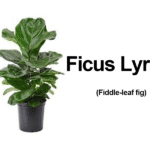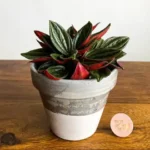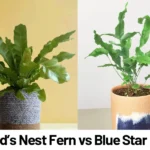Jade vs. Marble Queen: Which Pothos Is Right for You?
In the world of indoor plants, few species are as beloved and beginner-friendly as pothos. With their trailing vines, attractive foliage, and adaptability to indoor conditions, pothos have become an iconic choice for homes and offices alike. But among the many cultivars of pothos, two often spark confusion: the Pothos Jade and the Pothos Marble Queen. Both belong to the same species—Epipremnum aureum—and they share similar care needs, yet they differ in visual appearance, growth behaviors, and ideal environments.
Many plant enthusiasts find themselves choosing between the Jade and the Marble Queen without fully understanding their differences. While both are beautiful, low-maintenance vines suited for a range of indoor lighting conditions, the right choice depends on your specific goals—whether you’re after a hardy, fast-growing green wall or a decorative, variegated centerpiece. In this article, we’ll help you differentiate them and make a confident, informed decision.
Jade Pothos vs. Marble Queen Pothos: Quick Comparison Table
| Feature | Jade Pothos | Marble Queen Pothos |
|---|---|---|
| Botanical Name / Family | Epipremnum aureum ‘Jade’ / Araceae | Epipremnum aureum ‘Marble Queen’ / Araceae |
| Origin | Solomon Islands (species origin) | Solomon Islands (species origin) |
| Leaf Shape & Size | Oval, slightly heart-shaped; 3–6 inches long | Oval, slightly heart-shaped; 3–6 inches long |
| Leaf Appearance | Solid, dark green leaves with little to no variegation | Creamy white and green marbled leaves with irregular variegation |
| Growth Rate | Fast | Medium to slow (due to lower chlorophyll) |
| Stem Traits | Uniform green stems; supports faster node production | Green stems with variegated leaf nodes; slower internodal spacing |
| Light Requirements | Low to bright indirect light (50 to 1,000 lux) | Medium to bright indirect light (750 to 2,500 lux) for best variegation |
| Watering Needs | Allow top 2 inches to dry; water every 7–10 days | Same general needs; slightly more sensitive to overwatering |
| Humidity Preference | 40–60% RH (normal indoor range) | 50–70% RH preferred for leaf health |
| Pet Safety / Toxicity | Toxic to cats and dogs (calcium oxalates) | Toxic to cats and dogs (calcium oxalates) |
| Typical Price / Availability | Very common; $5–$15 for 4–6″ pot | Readily available; $8–$20 for 4–6″ pot |
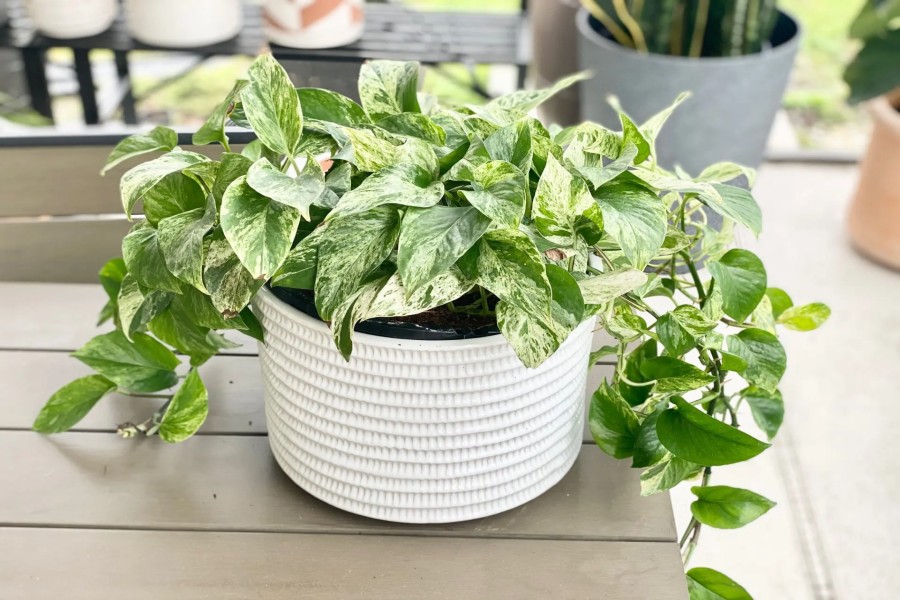
Key Differences Explained
Visual Identity and Foliage Color
The most apparent difference between Jade Pothos and Marble Queen is their foliage. Jade Pothos features deep, solid green leaves, giving it a lush, uniform appearance. This not only provides a strong visual impact in low-light rooms but also suggests a higher chlorophyll content for more vigorous growth. In contrast, the Marble Queen dazzles with its marbled cream-and-green patterns, offering a variegated and eye-catching look that’s ideal for decorative uses. However, this variegation dilutes the plant’s chlorophyll, which results in a slower growth rate compared to the Jade. If you’re looking to add visual texture or contrast to your plant collection, Marble Queen may be your go-to.
Growth Habits and Indoor Placement
Because its leaves are fully green, Jade Pothos tends to grow faster and is more adaptable to varying light conditions. It’s ideal for trailing across high shelves, climbing moss poles, or filling out lush hanging baskets in dim hallways. Marble Queen is more deliberate and compact in its growth and prefers brighter environments to maintain variegation. If placed in lower light, its pale portions may begin to fade or revert, reducing its visual appeal. This makes the Jade more suited for tight or dark spaces, while the Marble Queen thrives in well-lit living rooms or offices with consistent daylight exposure.
Light Sensitivity and Variegation Maintenance
Lighting needs are a common concern for new houseplant owners, and this is where these pothos diverge. Jade Pothos tolerates low light—typically as low as 50–100 lux—but will do best between 100–750 lux (bright indirect light). The Marble Queen requires more consistent brightness to sustain its creamy variegation. A range between 750–2,500 lux is optimal, meaning east- or west-facing windows are great spots. Without sufficient light, new Marble Queen leaves may emerge with more green than cream, eventually resembling Jade Pothos. So, if your home corners lack natural light, the Jade is a low-risk companion.
Care Difficulty and Resilience
From a care and maintenance perspective, Jade Pothos is slightly more forgiving. It recovers better from irregular watering and can better adapt to inconsistent humidity or occasional neglect. Marble Queen, thanks to its lower chlorophyll content and delicate variegation, is somewhat more sensitive to overwatering and low humidity. It benefits from dedicated attention to lighting and moisture balance. That said, both are considered beginner-friendly and tolerant plants, but Jade takes the lead when it comes to sheer durability and care flexibility.
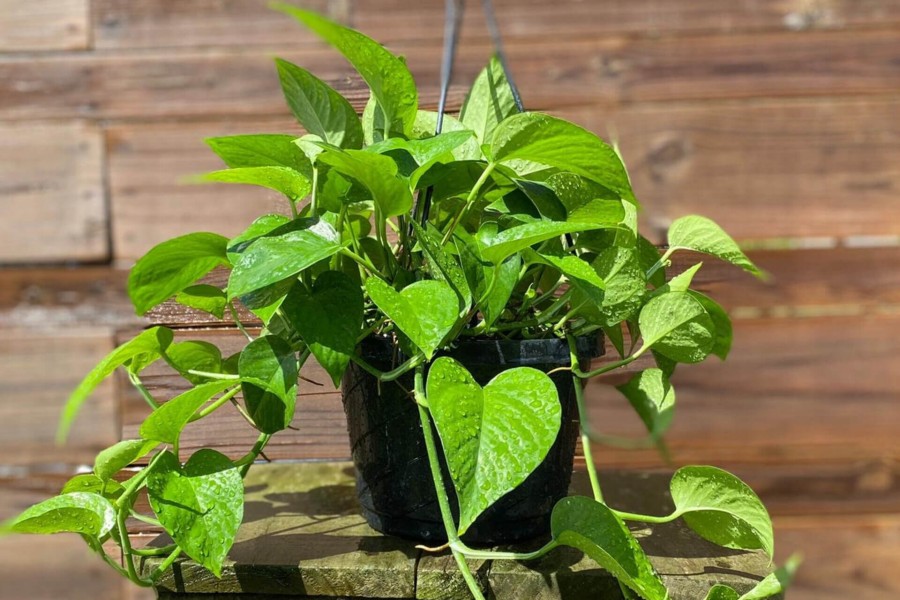
Which One Should You Choose?
Choosing between Jade and Marble Queen Pothos ultimately comes down to your space, lifestyle, and aesthetic preferences. Here are some quick recommendations to help you decide:
- Best for Beginners: Jade Pothos. Its solid green foliage grows quickly, tolerates lower light, and bounces back from common beginner mistakes like underwatering or occasional neglect.
- Best for Low Light Homes: Jade Pothos. It thrives even in less-than-ideal indoor lighting, such as bathrooms, hallways, or north-facing rooms.
- Best for Statement Décor: Marble Queen. The creamy variegated leaves are striking and refined, ideal for styled shelves or as a focal point near bright windows.
- Best for Small Apartments: Either, but Jade is better if you need a fast-growing plant to fill vertical space or trailing baskets.
- If You Have Pets: Unfortunately, both varieties are toxic to cats and dogs due to insoluble calcium oxalates. Keep them out of reach or opt for a pet-safe plant like a Calathea or Spider Plant.
If budget or ease of access is a factor, you’ll find both at most nurseries or big box stores. Jade Pothos is often cheaper and more readily available, while Marble Queen can command a slightly higher price due to its decorative appeal. Either way, both bring beauty and greenery indoors with minimal fuss.
Conclusion
Though similar in species and general care, Pothos Jade and Marble Queen serve different roles in the indoor plant world. Jade brings reliability, rapid growth, and flexibility for low-light or low-maintenance households. Marble Queen offers ornamental charm with its creamy hues and behaves better as a focal piece in brighter interiors. By understanding their differences—from leaf coloration to light requirements—you’ll be one step closer to choosing the perfect plant companion for your space and lifestyle.
References
- McLaughlin, J. M., & Merrow, M. (2022). Florida Plant Identification and Care Guide. University of Florida Extension Publications. https://edis.ifas.ufl.edu
- ASPCA. (2024). Toxic and Non-Toxic Plant List – Pothos. American Society for the Prevention of Cruelty to Animals. https://www.aspca.org/pet-care/animal-poison-control/toxic-and-non-toxic-plants/pothos
- Gough, R. E., & Moore-Gough, C. (2023). Indoor Plant Basics. Montana State University Extension Bulletin. https://store.msuextension.org



